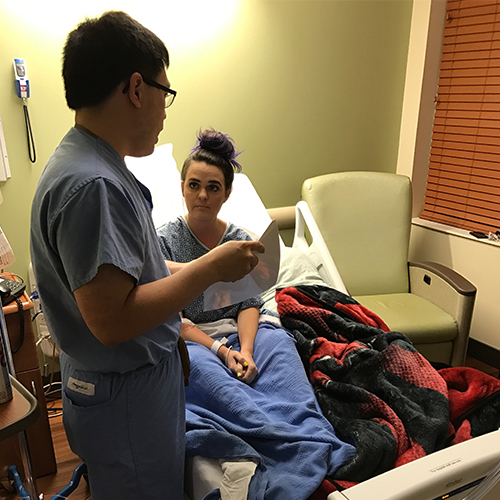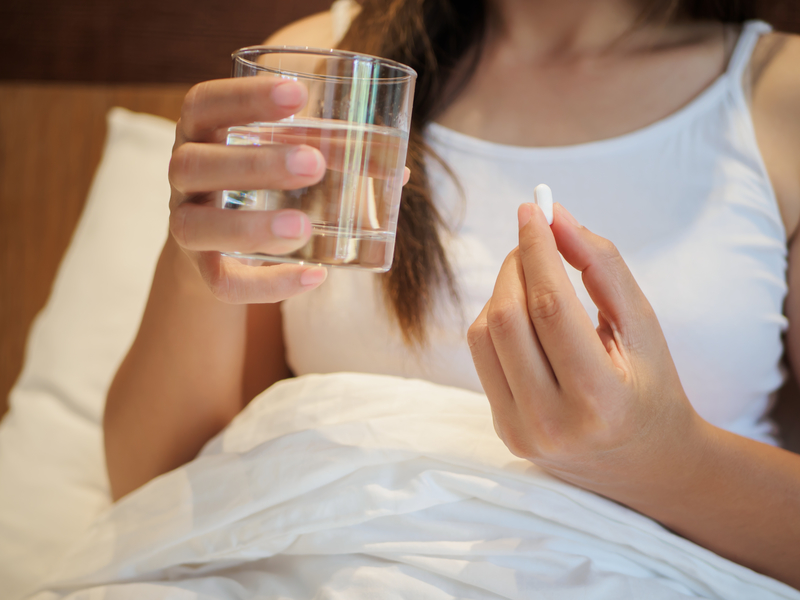
As dangerous as they are, opioids remain a seemingly easy fix for chronic pain—a sobering reality many women with endometriosis know all too well.
Lea Ervin never thought she would develop a dependency on opioids. She had already seen the ugliness of the pill-popping epidemic firsthand growing up in Arkansas and living in Blount County, Alabama, places where she says, "the opioid crisis is huge."
"I see it all the time, constantly," Ervin, 35, tells The Blossom. "I've had friends that I've known for a long time, whose lives I see spiral out of control with opioid addiction. Friends from high school pass away. I'm aware of it being out there very much. But I didn't think it could be me."
That all changed after her 2017 endometriosis excision surgery when Ervin, a first-year writing instructor at the University Alabama-Birmingham, was given a large prescription of oxycodone to erase the post-op pain.
Just a few weeks later, she felt herself teetering dangerously close to addiction.
"I found myself becoming physically dependent on the oxycodone. I told my husband 'I think I'm going to quit these and stop as soon as I can.' Well, as soon as I stopped, I had all the withdrawal symptoms." She recalls having nausea, restless legs and arms, sweats, mood swings and depression.
"The opioids scared me to death because what is the first thing that I do? I'd get out of bed in the middle of the night and take a pill before I could sleep. I found myself going for the pills and thinking: 'This is how it happens, isn't it?'
“It could happen to anybody."
Ervin's story, sadly, isn't unique. The Centers for Disease Control and Prevention reports that, in 2015 alone, drug overdoses accounted for 52,404 deaths. Within that number, 33,091—just over 63 percent—involved opioids. That number is higher than the 43,000 people who died in the U.S. due to HIV/AIDS at the height of the epidemic in 1995. The U.S. Department of Health and Human Services breaks it down even further: Every day, 116 people die from opioid-related overdoses.
Living with chronic pain
Ervin says her endo symptoms began at age 12, but she wasn't diagnosed until 26. For the next three years, she had three endo-related surgeries. After a 2011 hysterectomy, she experienced the bliss of a six-year-long stretch of relative comfort before the pains returned.
In 2017, she rushed to the ER with an intense flare-up. (Levin recently blogged about the experience for EndoFound.) She says her ER caretakers dismissed her pains and suspected she was fishing for opioids.
"It felt like they were like, 'Here, let's get her out of here, here are some pills,'" Ervin says.
On May 12, 2017, she had what she calls a "really extensive excision surgery," to reign in nagging pain. Throughout her endo journey, Ervin says doctors handed her prescriptions ranging in strength from Tylenol 3 to oxycodone—this time she decided to take them.
When she felt herself slipping into addiction, Ervin says she called her mom, who lives a six-hour drive away in Arkansas and asked her if she could stay with her to help wean her off the opioids. Her mom was there for her, as Ervin went through a gradual, week-long process to slowly get off the pills.
"She would give me pills in halves and then fourths and then stretch out the intervals of time between having pills. She did this for me until eventually, I didn't need them anymore," Ervin says.

"I'm so grateful I had parents who were able to do that and take that week and spend that time with me. My mom would check in with me and say, 'How are you feeling?' She'd help me fight through this, half hour-by-half hour."
Frankie Valentine, 42, also says the chronic pain of her endometriosis led her to be prescribed opioids. The U.S. Air Force veteran, illustrator, and graphic designer was diagnosed in 2009. She says that doctors have prescribed her hormone therapy and eventually hydrocodone/Vicodin, a highly-addictive opioid that she admits she takes only out of necessity. Valentine says she has not suffered from opioid addiction herself.
"At its worst, my endometriosis pain was so severe I could not stand and, sometimes, I exhibited symptoms of shock, like sweating and dizziness," Valentine says.
"Hydrocodone was frequently the only medicine that could affect my endometrial pain." Valentine says she recently turned to Flexeril, a muscle relaxer, which is also used to aid in opioid withdrawal, as an effective way to manage her endo pain.
"When I explained this to my PCM (primary care manager) recently, she was very surprised but said if it works, she was happy and renewed my prescription."
The Need to Move Away From Opioids
Winnie Chan, 30, has been hospitalized multiple times for endometriosis-related complications. Chan says that she was always struck that no matter the location—clinic, hospital or ER—she found her doctors and nurses wouldn't always be clear about what kind of pain treatment they were prescribing.
"A lot of people ask you, the nurses ask you, ‘What’s your pain level, one to ten? And when people say that they’re in category '5 or above,' the nurses will say, will suggest, 'would you like some medicine for pain?' That’s the first question. And if the patient says 'yes,' then the nurse will go and get some medication for pain.
“But they don’t tell you what is that medication," Chan tells The Blossom. "It could be Tylenol, or something crazier, like higher doses like Percocet, morphine or oxycodone. I think it’s the language right there. 'Do you want medication for your pain?' If people don’t know that—that pain medication could be something else, not Tylenol or Motrin, they would be knocked out by that medication. They wouldn’t even feel that pain anymore for a couple hours. So, it’s the way they ask you."
She recalls once, following an endometriosis-related surgery, she was given Dilaudid, a strong opioid that can be highly addictive. After taking the drug, Chan says she was “out” for six hours.
"I am sensitive to any kind of medication, so I started throwing up violently," she says.
"Even though I had no food in my body and I was post-surgery. I was like ahh…this is even worse because my scar hurts,' and a lot of doctors came to visit me, but my eyes were closed because I had no energy to wake up. I knew they were there, but I was just so out on Dilaudid."
Chan adds that some doctors' overreliance on opioids forces patients to be more educated themselves about the dangers of potential addiction. From her personal experience, Chan says more information should be readily available to patients.
"I’m not saying pain medication is not good; I try not to have any narcotics. That’s my personal preference for my body," she adds. "It’s the way people are educated about medication and the way you give it to them. You shouldn’t be saying, 'do you want pain medication?' You [should] say like, 'I’m going to give you a controlled substance medication. This will do this to your body. It will knock it out or whatever.'
“Educate the patient first before you give the type of pain medication. I experienced it at all kinds of hospitals."
EndoFound Founder Dr. Tamer Seckin agrees that healthcare providers play a huge role in fueling the opioid crisis when it comes to endo women.
"This is a serious, national crisis for the endometriosis population. Because doctors don’t know how to deal with endometriosis, it becomes an easy way out to prescribe painkillers and have the patient come back and prescribe them again," he says. "And that’s how patients innocently get trapped into opioid dependency, which is often very difficult to pull back from. It also complicates the outcome of good [endometriosis-related] treatment and care."

Eric D. Collins, physician-in-chief at Silver Hill Hospital in New Canaan, Conn., says that, in his experience as an addiction specialist, there really isn't evidence that opioids are "good for treating pain in the long run."
"I've treated a few people who got addicted to opioids after being treated for endometriosis. People with endometriosis and other conditions don't just get physically dependent, they continue the opioids for purposes other than pain management," he tells The Blossom.
"They seek them out and get more into problematic use of these pain medicines."
He says that often abuse of prescription pain meds can lead people down the road of seeking out heavier drugs that they acquire off the street, away from the moderation of doctors. While opioids might have seemed like a sensible way to treat pain in the 90s, Collins adds that the overreliance on these drugs has gotten out of control over the past several decades.
Like many health providers today, Collins sees opioids feeding into a "public health problem," where these medications are "out there more often than their true need" demands.
"I would say there just isn't good evidence out there that opioids are good for chronic pain," he adds. "Too many people focus on giving meds for pain, and some of that is driven by a healthcare system that minimizes time with doctors.
“Look, it takes more time to do all the other things that need to be done with people to help them manage their pain. That includes medication but also involves stress reduction and physical activity and regular exercise. In some instances, it could involve diet control. My concern is that there isn't a single study out there that shows women with endometriosis, for instance, have a better life when their chronic pain is treated with opioids."
What does Collins recommend for women looking for alternatives to opioids and who might be scared by the possibility of becoming addicted? He recommends a woman with endometriosis first seek out an expert in the field—not necessarily your general physician—who can help answer questions about the best way to treat her endo pain.
He says that while less common than alcohol rehabilitation programs, there are some 12-step-style programs out there to help people deal with addiction tied to chronic pain. Collins adds that something as simple as volunteer work and exercise—really anything that gets you moving and out of your house—can help you deal with some of the depression and mood problems that can co-occur with both addiction and chronic pain.
Collins says, quite simply, more work needs to be done to ensure women who suffer from pain tied to endometriosis get the best treatment possible.
"Endometriosis is like all chronic illnesses in that we need to understand it more and we need more research on it to help people with their chronic pain," he stresses. "Chronic pain management for endometriosis, like chronic pain management for something like arthritis, might require more research, more vigilance on the part of the medical community. We need to support all the research we can to find the most effective and valuable treatments for endometriosis and chronic pain."
The Insurance Problem
Tommaso Falcone, MD, chairman of the Ob/Gyn & Women's Health Institute at Cleveland Clinic, claims insurance companies are big players in fueling the opioid crisis.
"At our clinic, we emphasize a multi-disciplinary approach to all chronic diseases with pain. It could involve medications but also physical therapy and more holistic approaches.
“The problem with this epidemic—you have a shared responsibility between the medical community and the insurance companies," Dr. Falcone tells The Blossom.
"The insurance companies will say 'we are not going to pay for psychotherapy, we are not going to pay for massage therapy, we are not going to pay for acupuncture, not pay for stress management.' Suddenly, as a result, you are eliminating access to these things that work at managing pain."
Falcone says that a woman being treated for endometriosis might look at those insurance costs and say, "I just can't pay this" when treatments beyond drugs are presented. This forces some doctors out there to default to prescribing opioids. He says this is why we are in the "mess we are in today" as a nation.
He says the current opioid epidemic—punctuated by experiences by people like Ervin and Chan, who found painkillers make life harder rather than easier—has "forced everyone to reassess the way we treat these women's pain."
According to him, the crisis has "opened our eyes" to the benefits of more holistic and interdisciplinary approaches to care, but the significant roadblock rests in insurance companies' reluctance to support treatments that don't feed the drug industry.
Falcone says that at Cleveland Clinic, opioids are rarely prescribed. They might be given to a woman to treat post-op pain but says he and his team focus on a more holistic approach, working with other professionals within the clinic to offer acupuncture, massage treatments, nutrition consultations, and yoga, among other forms of alternative, sometimes outside-the-box therapies.
While Cleveland Clinic might be moving away from the pain pills that can lead to addiction, Falcone acknowledges that is, unfortunately, not the norm in other hospitals and treatment centers around the country.
"Alternatives to opioids are the answer; there are things you can do, but there is a cost to those things, and we need to figure out how to get this alternative more readily available for women, so we don’t have the crisis we have today."









